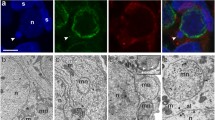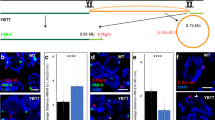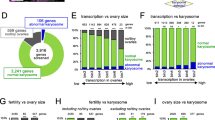Abstract
Heterochromatin protein 1 (HP1) is a highly conserved family of eukaryotic proteins required for heterochromatic gene silencing and euchromatic gene transcription regulation. In addition, HP1 is involved in chromatin organization and protection of chromosome integrity during cell division. Here, we present a cytological and molecular analysis of the effects of HP1 knockdown in Eyprepocnemis plorans, a grasshopper species polymorphic for supernumerary heterochromatic chromosomes. Our results revealed contrasting effects of HP1 knockdown on gene activity. While the Bub1 gene decreased in expression level in HP1 knockdown animals, NOR activity, rRNA and, contrarily to previous reports in Drosophila, Hsp70 gene expression remained unchanged. Furthermore, HP1 knockdown resulted in abnormal chromatin condensation, chromosomal bridges, higher frequency of macrospermatids, loss of muscle mass and hemolymph amount as well as a low number of dividing cells and survival reduction. All these phenotypes are very likely due to the chromatin condensation disruption observed for almost all kinds of chromatin.



Similar content being viewed by others
Abbreviations
- Bub1:
-
Budding uninhibited by benzimidazoles 1
- cDNA:
-
Complementary deoxyribonucleic acid
- Dffi:
-
Days from the first injection
- dsRNA:
-
Double-stranded ribosomal ribonucleic acid
- E. plorans :
-
Eyprepocnemis plorans
- FISH:
-
Fluorescent in situ hibridization
- gDNA:
-
Genomic deoxyribonucleic acid
- HKG:
-
Housekeeping gene
- HP1:
-
Heterochromatin protein 1
- Hsp70:
-
70 kilodaltons heat shock protein
- ITS2:
-
Internal transcribed spacer 2
- NOR:
-
Nucleolus organizer region
- qRT-PCR:
-
Quantitative reverse transcription-polymerase chain reaction
- rDNA:
-
Ribosomal deoxyribonucleic acid
- rRNA:
-
Ribosomal ribonucleic acid
- RNAi:
-
Interference ribosomal ribonucleic acid
- SAC:
-
Spindle assembly checkpoint
- satDNA:
-
Satellite deoxyribonucleic acid
References
Aucott R, Bullwinkel J, Yu Y et al (2008) HPI-β is required for development of the cerebral neocortex and neuromuscular junctions. J Cell Biol 183:597–606
Baker DJ, Dawlaty MM, Wijshake T et al (2013) Increased expression of BubR1 protects against aneuploidy and cancer and extends healthy lifespan. Nat Cell Biol 15:96–102
Bakkali M, Cabrero J, López-León MD, Perfectti F, Camacho JPM (1999) The B chromosome polymorphism of the grasshopper Eyprepocnemis plorans in North Africa I. B variants and frequency. Heredity 83:428–434
Banaei-Moghaddam AM, Meier K, Karimi-Ashtiyani R, Houben A (2013) Formation and expression of pseudogenes on the B chromosome of rye. Plant Cell 25:2536–2544
Baroni S, Lopes CE, de Almeida-Toledo LF (2009) Cytogenetic characterization of Metynnis maculatus (Teleostei; Characiformes): the description in Serrasalminae of a small B chromosome bearing inactive NOR-like sequences. Caryologia 62:95–101
Basu J, Bousbaa H, Logarinho E et al (1999) Mutations in the essential splindle checkpoint gene Bub1 cause chromosome missegregation and fail to block apoptosis in Drosophila. J Cell Biol 146:13–28
Bernard P, Hardwich K, Javerzat JP (1998) Fission yeast Bub1 is a mitotic centromere protein essential for the spindle checkpoint and the preservation of correct ploidy through mitosis. J Cell Biol 143:1775–1787
Bidau CJ (1986) A nucleolar-organizing B chromosome showing segregation-distortion in the grasshopper Dichroplus pratensis (Melanoplinae, Acrididae). Can J Genet Cytol 28:138–148
Boeskorov GG, Kartavtseva IV, Zagorodniuk IV, Belianin AN, Liapunova EA (1995) Nucleolus organizer regions and B-chromosomes of field mice (Mammalia, Rodentia, Apodemus). Genetika 31:185–192
Cabrero J, Alché JD, Camacho JPM (1987) Effects of B chromosomes of the grasshopper Eyprepocnemis plorans on nucleolar organiser regions activity. Activation of a latent NOR on a B chromosome fused to an autosome. Genome 29:116–121
Cabrero J, López-León MD, Bakkali M, Camacho JPM (1999) Common origin of B chromosome variants in the grasshopper Eyprepocnemis plorans. Heredity 83:435–439
Cabrero J, Bugrov A, Warchalowska-Sliwa E, López-León MD, Perfectti F, Camacho JPM (2003) Comparative FISH analysis in five species of Eyprepocnemidine grasshoppers. Heredity 90:377–381
Cabrero J, Teruel M, Carmona FD, Camacho JPM (2007) Histone H2AX phosphorylation is associated with most meiotic events in grasshopper. Cytogenet Genome Res 116:311–315
Cabrero J, Bakkali M, Navarro-Domínguez B et al (2013) The Ku70 DNA-repair protein is involved in centromere function in a grasshopper species. Chromosome Res 21:393–406
Camacho JPM (2005) B chromosomes. In: Gregory TR (ed) The evolution of the genome. Elsevier, San Diego, pp 223–286
Camacho JPM, Cabrero J, Viseras E, López-León MD, Navas-Castillo J, Alché JD (1991) G-banding in two species of grasshoppers and its relationship to C, N, and fluorescence banding techniques. Genome 34:638–643
Canudas S, Houghtaling BR, Bhanot M et al (2011) A role for heterochromatin protein 1γ at human telomeres. Genes Dev 25:1807–1819
Carchilan M, Kumke K, Mikolajewski S, Houben A (2009) Rye B chromosomes are weakly transcribed and might alter the transcriptional activity of A chromosome sequences. Chromosoma 118:607–616
Chapuis MP, Tohidi-Esfahani D, Dodgson T et al (2011) Assessment and validation of a suite of reverse transcription-quantitative PCR reference genes for analyses of density-dependent behavioural plasticity in the Australian plague locust. BMC Mol Biol 12:7
Corey HI (1938) Heteropycnotic elements of orthopteran chromosomes. Arch Biol 49:159–172
De Lucia F, Ni JQ, Vaillant C, Sun FL (2005) HP1 modulates the transcription of cell-cycle regulators in Drosophila melanogaster. Nucleic Acids Res 33:2852–2858
Dinant C, Luijsterburg MS (2009) The emerged role of HP1 in the DNA damage response. Mol Cell Biol 29:6335–6340
Eissenberg JC, Elgin SC (2000) The HP1 protein family: getting a grip on chromatin. Curr Opin Genet Dev 10:204–210
Fanti L, Pimpinelli S (2008) HP1: a functionally multifaceted protein. Curr Opin Genet Dev 18:169–174
Fanti L, Giovinazzo G, Berloco M, Pimpinelli S (1998) The heterochromatin protein 1 prevents telomere fusions in Drosophila. Mol Cell 2:527–538
Fanti L, Berloco M, Piacentini L, Pimpinelli S (2003) Chromosomal distribution of heterochromatin protein 1 (HP1) in Drosophila: a cytological map of euchromatic HP1 binding sites. Genetica 117:135–147
Hamperl S, Wittner M, Babl V, Perez-Fernandez J, Tschochner H, Griesenbeck J (2013) Chromatin states at ribosomal DNA loci. Biochim Biophys Acta 1829:405–417
Hayakawa T, Haraguchi T, Masumoto H, Hiraoka Y (2003) Cell cycle behaviour of human HP1 subtypes: distinct molecular domains of HP1 are required for their centromeric localization during interphase and metaphase. J Cell Sci 116:3327–3338
Hayashi MT, Takahashi TS, Nakagawa T, Nakayama J, Masukata H (2009) The heterochromatin protein Swi6/HP1 actives replication origins at the pericentromeric region and silent mating-type locus. Nat Cell Biol 11:357–362
Herndon LA, Schmeissner PJ, Dudaronek JM et al (2002) Stochastic and genetic factors influence tissue-specific decline in ageing C. elegans. Nature 419:808–814
Horáková AH, Bártová E, Galiová G, Uhlírová R, Matula P, Kozubek S (2010) SUV39h-independent association of HP1β with fibrillarin-positive nucleolar regions. Chromosoma 119:227–241
Ishak B, Jaafar H, Maetz JL, Rumpler Y (1991) Absence of transcriptional activity of the B-chromosome of Apodemus peninsulae during pachytene. Chromosoma 100:278–281
James TC, Elgin SC (1986) Identification of a non histone chromosomal protein associated with heterochromatin in Drosophila melanogaster and its gene. Mol Cell Biol 6:3862–3872
Kalendar R, Lee D, Schulman AH (2009) FastPCR software for PCR primer and probe design and repeat search. Genes, Genomes and Genomics 3:1–14
Kellum R, Raff JW, Alberts BM (1995) Heterochromatin protein 1 distribution during development and during the cell cycle in Drosophila embryos. J Cell Sci 108:1407–1418
Kwon SH, Workman JL (2011) The changing faces of HP1: From heterochromatin formation and gene silencing to euchromatic gene expression: HP1 acts as a positive regulator of transcription. Bioessays 33:280–289
Larson K, Yan SJ, Tsurumi A et al (2012) Heterochromatin formation promotes longevity and represses ribosomal RNA synthesis. PLoS Genet 8:e1002473
Leach CR, Houben A, Field B, Pistrick K, Demidov D, Timmis JN (2005) Molecular evidence for transcription of genes on a B chromosome in Crepis capillaris. Genetics 171:269–278
Lee DH, Li Y, Shin DH et al (2013) DNA microarray profiling of genes differentially regulated by three heterochromatin protein 1 (HP1) homologs in Drosophila. Biochem Biophys Res Commun 434:820–828
Liu LP, Ni JQ, Shi YD, Oakeley EJ, Sun FL (2005) Sex-specific role of Drosophila melanogaster HP1 in regulating chromatin structure and gene transcription. Nat Genet 37:1361–1366
Liu GH, Barkho BZ, Ruiz S et al (2011) Recapitulation of premature ageing with iPSCs from Hutchinson-Gilford progeria syndrome. Nature 472:221–225
López-León MD, Neves N, Schwarzacher T, Heslop-Harrison JS, Hewitt GM, Camacho JPM (1994) Possible origin of a B chromosome deduced from its DNA composition using double FISH technique. Chromosome Res 2:87–92
López-León MD, Cabrero J, Camacho JPM (1995) Changes in NOR activity pattern in the presence of supernumerary heterochromatin in the grasshopper Eyprepocnemis plorans. Genome 38:68–74
Lucchini R, Sogo JM (1998) The dynamic structure of ribosomal RNA gene chromatin. In: Paule MR (ed) Transcription of ribosomal RNA genes by eukaryotic RNA polymerase I. Landes Bioscience, Austin, pp 255–276
Luijsterburg MS, Dinant C, Lans H et al (2009) Heterochromatin protein 1 is recruited to various types of DNA damage. J Cell Biol 185(4):577–586
Meyne J, Hirai H, Imai HT (1995) FISH analysis of the telomere sequences of bulldog ants (Myrmecia: Formidae). Chromosoma 104:14–18
Motamedi MR, Hong EJ, Li X et al (2008) HP1 proteins form distinct complexes and mediate heterochromatic gene silencing by nonoverlapping mechanisms. Mol Cell 32:778–790
Muñoz-Pajares AJ, Martínez-Rodríguez L, Teruel M, Cabrero J, Camacho JPM, Perfectti F (2011) A single, recent origin of the accessory B chromosome of the grasshopper Eyprepocnemis plorans. Genetics 187:853–863
Nonaka N, Kitajima T, Yokobayashi S et al (2002) Recruitment of cohesion to heterocromatic regions by Swi6/HP1 in fission yeast. Nat Cell Biol 4:89–93
Piacentini L, Fanti L, Berloco M, Perrini B, Pimpinelli S (2003) Heterochromatin protein 1 (HP1) is associated with induced gene expression in Drosophila euchromatin. J Cell Biol 161:707–714
Piacentini L, Fanti L, Negri R et al (2009) Heterochromatic protein 1 (HP1a) positively regulates euchromatic gene expression through RNA transcript association and interaction with hnRNPs in Drosophila. PLoS Genet 5(10):e1000670
Poletto AB, Ferreira IA, Martins C (2010) The B chromosomes of the African cichlid fish Haplochromis obliquidens harbour 18S rRNA gene copies. BMC Genet 11:1
Poletto AB, Ferreira IA, Martins C (2012) The B chromosomes of the African cichlid fish Haplochromis obliquidens harbour 18S rRNA gene copies. BMC Genet 13:3
Rozen S, Skaletsky H (2000) Primer3 on the WWW for general users and for biologist programmers. Methods Mol Biol 132:365–386
Rufas JS, Iturra P, De Souza W, Esponda P (1982) Simple silver staining procedure for the localization of nucleolus and nucleolar organizer under light and electron microscopy. Arch Biol 93:267–274
Ruiz-Estévez M, López-León MD, Cabrero J, Camacho JPM (2012) B-Chromosome ribosomal DNA is functional in the grasshopper Eyprepocnemis plorans. PLoS ONE 7(5):e36600
Ruiz-Estévez M, López-León MD, Cabrero J, Camacho JPM (2013) Ribosomal DNA is active in different B chromosome variants of the grasshopper Eyprepocnemis plorans. Genetica 141:337–345
Ruiz-Ruano FJ, Ruiz-Estévez M, Rodríguez-Pérez J, López-Pino JL, Cabrero J, Camacho JPM (2011) DNA Amount of X and B chromosomes in the grasshoppers Eyprepocnemis plorans and Locusta migratoria. Cytogenet Genome Res 134:120–126
Savitsky M, Kravchuk O, Melnikova L, Georgiev P (2002) Heterochromatin Protein 1 is involved in control of telomere elongation in Drosophila melanogaster. Mol Cell Biol 22:3204–3218
Schneider CA, Rasband WS, Eliceiri KW (2012) NIH Image to ImageJ: 25 years of image analysis. Nature Methods 9:671–675
Schott S, Coustham V, Simonet T, Bedet C, Palladino F (2006) Unique and redundant functions of C. elegans HP1 proteins in post-embryonic development. Dev Biol 298:176–187
Schwaiger M, Kohler H, Oakeley EJ, Stadler MB, Schübeler D (2010) Heterochromatin protein (HP1) modulates replication timing of Drosophila genome. Genome Res 20:771–780
Sdek P, Oyama K, Angelis E, Chan SS, Schenke-Layland K, MacLellan WR (2013) Epigenetic regulation of myogenic gene expression by heterocromatic protein 1 alpha. PLoS ONE 8(3):e58319
Serrano A, Rodríguez-Corsino M, Losada A (2009) Heterochromatin Protein 1 (HP1) do not drive pericentromeric cohesin enrichment in human cells. PLoS One 4(4):e5118
Sharma GG, Hwang KK, Pandita RK et al (2003) Human heterochromatin protein 1 isoforms HP1Hsα and HP1Hsβ interfere with hTERT-telomere interactions and correlate with changes in cell growth and response to ionizing radiation. Mol Cell Biol 23:8363–8376
Spierer A, Seum C, Delattre M, Spierer P (2005) Loss of the modifiers of variegation Su(var)3–7 or HP1 impacts male X polytene chromosome morphology and dosage compensation. J Cell Sci 118:5047–5057
StatSoft, Inc. (2007) STATISTICA (data analysis software system), version 8.0. www.statsoft.com
Stitou S, Díaz de la Guardia R, Jiménez R, Burgos M (2000) Inactive ribosomal cistrons are spread throughout the B chromosomes of Rattus rattus (Rodentia, Muridae). Implications for their origin and evolution. Chromosome Res 8:305–311
Studencka M, Wesolowski R, Opitz L, Salinas-Riester G, Wisniewski JR, Jedrusik-Bode M (2012) Transcriptional repression of Hox genes by C. elegans HP1/HPL and H1/HIS-24. PLoS Genet 8(9):e1002940
Teruel M, Cabrero J, Perfectti F, Camacho JPM (2007) Nucleolus size variation during meiosis and NOR activity of a B chromosome in the grasshopper Eyprepocnemis plorans. Chromosome Res 15:755–765
Teruel M, Cabrero J, Perfectti F, Camacho JPM (2009) Quantitative analysis of NOR expression in a B chromosome of the grasshopper Eyprepocnemis plorans. Chromosoma 118:291–301
Teruel M, Sørensen JG, Loeschcke V, Cabrero J, Perfectti F, Camacho JPM (2011) Level of heat shock proteins decreases in individuals carrying B-chromosomes in the grasshopper Eyprepocnemis plorans. Cytogenet Genome Res 132:94–99
Van Hiel MB, Van Wielendaele P, Temmerman L et al (2009) Identification and validation of housekeeping genes in brains of the desert locust Schistocerca gregaria under different developmental conditions. BMC Mol Biol 10:56
Van Vugt JJ, de Nooijer S, Stouthamer R, de Jong H (2005) NOR activity and repeat sequences of the paternal sex ratio chromosome of the parasitoid wasp Trichogramma kaykai. Chromosoma 114:410–419
Vandesompele J, De Preter K, Pattyn F et al. (2002) Accurate normalization of real-time quantitative RT-PCR data by geometric averaging of multiple internal control genes. Genome Biol 3:research0034.1-0034.11
Vermaak D, Malik HS (2009) Multiple roles for heterochromatin protein 1 genes in Drosophila. Annu Rev Genet 43:467–492
Wang G, Ma A, Chow CM et al (2000) Conservation of heterochromatin protein 1 function. Mol Cell Biol 20:6970–6983
Warren CD, Brady DM, Johnston RC, Hanna JS, Hardwick KG, Spencer FA (2002) Distinct chromosome segregation roles for spindle checkpoint proteins. Mol Biol Cell 13:3029–3041
Acknowledgements
We thank T. López for technical assistance and Karl Meunier for language revision. This study was supported by a grant from the Spanish Ministerio de Ciencia e Innovación (CGL2009-11917) and Plan Andaluz de Investigación (CVI-6649), and was partially performed by FEDER funds. M Ruiz-Estévez was supported by a FPU fellowship from the Spanish Ministerio de Ciencia e Innovación. M. Bakkali wishes to thank the Spanish Ministerio de Ciencia e Innovación both for the grant (BFU2010-16438) and for the Ramón y Cajal Fellowship.
Integrity of research
All experiments comply with the current Spanish laws. All institutional and national guidelines for the care and use of laboratory animals were followed.
Conflict of interest
Mercedes Ruíz-Estévez, Mohammed Bakkali, Josefa Cabrero, Juan Pedro M Camacho and María Dolores López-León declare that they have no conflict of interest.
Author information
Authors and Affiliations
Corresponding author
Additional information
Responsible Editor: Beth Sullivan
Rights and permissions
About this article
Cite this article
Ruiz-Estévez, M., Bakkali, M., Cabrero, J. et al. HP1 knockdown is associated with abnormal condensation of almost all chromatin types in a grasshopper (Eyprepocnemis plorans). Chromosome Res 22, 253–266 (2014). https://doi.org/10.1007/s10577-013-9399-z
Received:
Revised:
Accepted:
Published:
Issue Date:
DOI: https://doi.org/10.1007/s10577-013-9399-z




